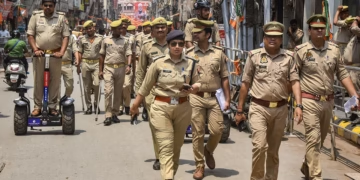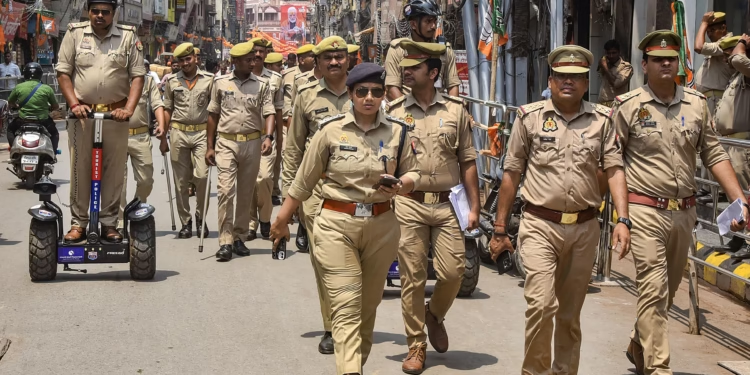The India Justice Report 2025 reveals a stark gender disparity in the police force, highlighting that fewer than 1,000 women hold top-ranking positions nationwide. Shockingly, nearly 90% of all female personnel continue to serve in the lowest tier — the constabulary.
The India Justice Report (IJR) 2025 sheds light on the stark gender imbalance in India’s law enforcement sector. Despite ongoing conversations about the importance of diversity and inclusion, the report highlights that fewer than 1,000 women occupy senior police roles such as Director General or Superintendent of Police across the country.
Only 960 Women in IPS Ranks
Out of a total of 2.4 lakh women currently serving in the police, only 960 women hold Indian Police Service (IPS) ranks. Additionally, 24,322 women occupy non-IPS officer positions, including roles like Deputy Superintendent, Inspector, and Sub-Inspector. Shockingly, nearly 90% of women in the force remain confined to constabulary positions, pointing to a glass ceiling that continues to persist.
No State Meets Women’s Representation Target
The report, titled “Ranking States on the Capacity of Police, Judiciary, Prisons, and Legal Aid,” reveals that no state or Union Territory has yet achieved its target for women’s representation in the police force. As of January 2023, women accounted for just 12.3% of the total police strength, a slight increase from 11.7% in January 2022.
This percentage includes personnel across the civil police, District Armed Reserve (DAR), Special Armed Police Battalion, and the Indian Reserve Battalion (IRB).
Bihar Leads, But Some States See a Decline
Among the 18 large and mid-sized states surveyed, Bihar leads with 24% women’s representation in the police force. The state also recorded the highest growth, rising from 21% in 2022 to 24% in 2024.
However, nine states and Union Territories, including Telangana, Madhya Pradesh, and West Bengal, witnessed a decline in the number of women in police roles over the same period.

Madhya Pradesh Tops in Women DySPs
Interestingly, Madhya Pradesh holds the distinction of having the highest number of women Deputy Superintendents of Police (DySPs), with a total of 133 officers in this rank.
India Justice Report 2025 Highlights Deep Inequities in Law Enforcement and Judiciary
Despite increasing awareness about the importance of gender diversity in law enforcement, not a single Indian state or Union Territory has achieved its target for women’s representation in the police force, according to the India Justice Report (IJR) 2025, released on Tuesday.
The report paints a concerning picture: at current recruitment rates, states like Andhra Pradesh and Bihar could reach the 33% benchmark for women in police forces in about three years. However, for states and UTs like Jharkhand, Tripura, and the Andaman and Nicobar Islands, this goal could take nearly two centuries to achieve.
Gender & Caste Disparity in Judiciary
The report also highlights glaring gender gaps in the judiciary. While women now make up 38% of judges in the lower judiciary, this number drops drastically to just 14% in High Courts. Despite steady growth in the subordinate judiciary across states, a similar rise has not been observed in higher courts.
Furthermore, the representation of marginalized communities remains inadequate. In the district judiciary, Scheduled Tribes (STs) hold only 5% of positions, and Scheduled Castes (SCs) occupy 14%, indicating a significant shortfall in inclusive representation.
Job Quota Compliance Lags Behind
The report found that many states are falling short in meeting mandated job quota targets. Only 5 states met the SC quota at the officer level, compared to 7 states for STs and 9 for OBCs. In the police force, SCs account for 17% and STs 12%, both below proportional representation.
Judge-Population Ratio Still Alarmingly Low
India continues to grapple with a severely low judge-to-population ratio. With just 15 judges per million people, the country falls far short of the Law Commission’s 1987 recommendation of 50 judges per million.
The High Courts are operating with a 33% vacancy rate, while district courts are short by 21%. Judges in High Courts like Allahabad and Madhya Pradesh are managing up to 15,000 cases each, whereas district court judges handle about 2,200 cases on average.

Crisis in Prisons
The report also sheds light on India’s worsening prison conditions. The national average occupancy rate stands at 131%, indicating significant overcrowding. In Uttar Pradesh, one in every three jails is operating at over 250% capacity.
Medical staffing in prisons is equally alarming, with a prisoner-to-doctor ratio of 775:1, far exceeding the recommended 300:1. In major states like Haryana, West Bengal, and Uttar Pradesh, this ratio is worse—exceeding 1,000:1.
State Rankings & Improvements
Among smaller states, Sikkim topped the justice delivery index, followed by Himachal Pradesh and Arunachal Pradesh. In larger states, Karnataka retained its No. 1 rank, followed by Andhra Pradesh, Telangana, Kerala, and Tamil Nadu—with southern states leading due to stronger diversity, infrastructure, and staffing.
States like Bihar, Chhattisgarh, and Odisha showed the most notable improvements between 2022 and 2025. Uttar Pradesh and Uttarakhand also advanced on the index, surpassing Gujarat and Haryana.
A Call for Systemic Reform
The India Justice Report 2025 also evaluated the functioning of 25 State Human Rights Commissions and featured in-depth essays on access to justice for persons with disabilities and mediation as an alternative dispute resolution mechanism.
Backed by a collaboration of six prominent organizations—including the Centre for Social Justice (IDEAL), Common Cause, Commonwealth Human Rights Initiative (CHRI), Daksh, TISS-Prayas, and Vidhi Centre for Legal Policy—the report draws from trusted government data sources such as NCRB, Ministry of Law and Justice, National Judicial Data Grid (NJDG), and Prison Statistics India.
The India Justice Report 2025 underscores the urgent need for systemic reforms and proactive measures to improve gender diversity in the police force. While a few states have made progress, the majority still have a long way to go in ensuring equal opportunities and representation for women in law enforcement.















 Categories
Categories










